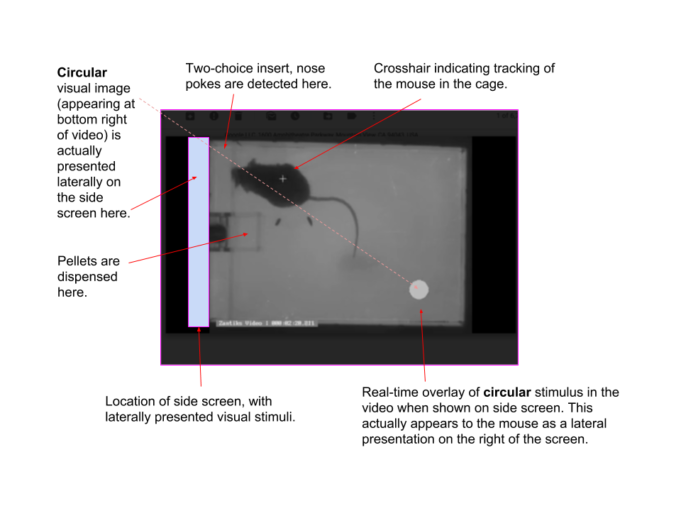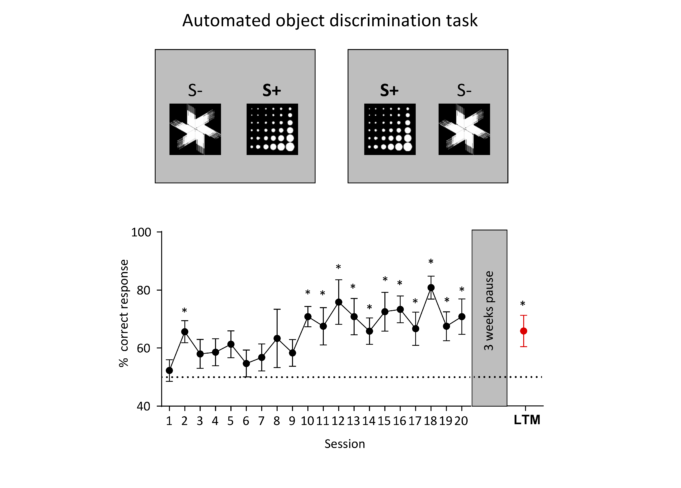This task is often used with mice to study emotional and cognitive disabilities.
Many neurological and psychiatric disorders are characterised by cognitive deficits, such as inflexibility, poor decision making, and impulsivity. Rodents are an important tool for studying the underlying genetics and molecular mechanisms of such deficits. Goal-directed discrimination and reversal learning tasks are widely used measures to model these symptoms in rodents.
Two-choice assay with mouse. The side screen is situated at the front of the chamber; the two choice insert includes a food hopper. The unit can detect activity in the zones in front of where the images are displayed. It is also set up to detect activity in the food hopper. The images on the side screen are overlaid on the video. Where an image appears in the video on the left, it will be appearing in real-time to the mouse on the left of the side screen, and vice versa. Video courtesy of Dr. Mariana Gil, Department of Clinical Neurobiology, Medical Faculty of Heidelberg University and DKFZ.
Experimental set up
The screen-based Zantiks AD system provides the possibility to test two-choice discrimination and reversal learning tasks for mice. A side screen can be used to laterally present visual stimuli, which is often the chosen method for researchers working with rodents.
The side screen can be set up either alongside (as shown in the video and illustration above) or at the opposite end (as shown in the photos below) to the food hopper. An insert is placed in the cage, in front of the side screen. The images appear within recessed zones in the insert (see the illustration of the insert below). The unit can then detect any activity ('nose pokes') made in these zones.
The inserts can be designed with large or small recessed zones to accommodate the image size and they can incorporate a food hopper. To see this in action, view the video above.
Processed results can be obtained at the end of each experiment. These can include the performance of the mouse (number of correct responses relative to the total responses) and the reaction times. In addition it is possible to track the movement of the animal, which can be used to create a heat map of the animal's activity, before it responds to a stimulus.

Experimental procedure
In a two-choice discrimination task, animals are trained to discriminate between two different visual stimuli (e.g., different colours or shapes) by nose poking to the objects presented on a lateral screen. The trials can be self-initiated or automatically presented after a specified inter-trial interval time (ITI). One stimulus on the screen is associated with reward, which could be a food pellet via the integrated feeder or any liquid reward (e.g. milkshake) via the integrated peristaltic pump. If the animal responds to the unrewarded object (i.e., incorrect response) no reward would be delivered and it can be punished by predefined timeout, typically a 5 second lights off time period.
In reversal learning, once acquisition of the discrimination is established, the reward contingency is reversed. The previously rewarded stimulus will now be unrewarded and/or punished, whereas the other stimulus will now be rewarded. Brain or genetic manipulations might change the animals’ flexibility to cope with this change implying involvement of the manipulation in an psychological disorder.

Results / data output
The figure below shows the learning curve for 6 mice in an object discrimination task using the Zantiks AD unit. The mice began discriminating between two stimuli (S+ vs S-) after 9 sessions and their performance remained above 70% for the next 11 sessions. After a three week break, they still remembered the rewarded stimulus (S+) implying long-term memory consolidation.
Data courtesy of Dr. Mariana Gil, Department of Clinical Neurobiology, Medical Faculty of Heidelberg University and DKFZ.

References



